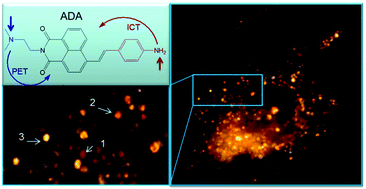A fluorescent pH probe for acidic organelles in living cells†
Abstract
A water-soluble pH sensor, 2-(6-(4-aminostyryl)-1,3-dioxo-1H-benzo[de]isoquinolin-2(3H)-yl)-N, N-dimethylethanamine (ADA), was synthesized based on the molecular design of photoinduced electron transfer (PET) and intramolecular charge transfer (ICT). The fluorescence emission response against a pH value is in the range 3–6, which is suitable for labelling intracellular pH-dependent microenvironments. After biological evolution, ADA is more than a pH biosensor because it is also an endocytosis pathway tracking biosensor that labels endosomes, late endosomes, and lysosome pH gradients. From this, the emissive aggregates of ADA and protonated-ADA in these organs were evaluated to explore how this probe stresses emission colour change to cause these unique cellular images.



 Please wait while we load your content...
Please wait while we load your content...